1996 PONTIAC GRAND-AM steering wheel
[x] Cancel search: steering wheelPage 30 of 356

Mow the Air Bag System Works
Where is the air bag?
The driver’s air bag is in the middle of the steering
wheel. The
right front passenger’s air bag is in the instrument
panel on
the passenger’s side.
1-22
ProCarManuals.com
Page 31 of 356
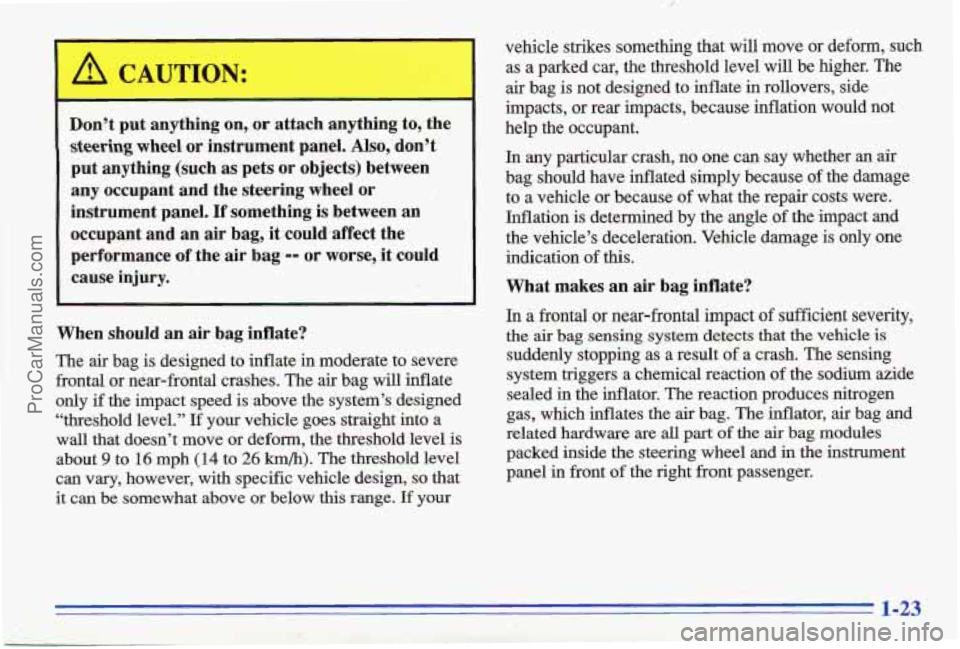
- I
Don’t put anything on, or attach anything to, the
steering wheel or instrument panel. Also, don’t
put anything (such as pets or objects) between
any occupant and the steering wheel or
instrument panel. If something is between
an
occupant and an air bag, it could-affect the
performance of the air bag
-- or worse, it could
cause injury.
When should an air bag inflate?
The air bag is designed to inflate in moderate to severe
frontal or near-frontal crashes. The air bag will inflate
only
if the impact speed is above the system’s designed
“threkhold level.”
If your vehicle goes straight into a
wall that doesn’t move or deform, the threshold level
is
about 9 to 16 mph (14 to 26 km/h). The threshold level
can
vary, however, with specific vehicle design, so that
it can be somewhat above or below this range. If your vehicle strikes something that will
move or deform, such
as a parked car, the threshold level will be higher. The
air bag is not designed to inflate in rollovers, side
impacts,
or rear impacts, because inflation would not
help the occupant.
In any particular crash, no one can say whether an air
bag should have inflated simply because
of the damage
to
a vehicle or because 6f what the repair costs were.
Inflation
is determined by the angle ,of the impact and
the vehicle’s deceleration. Vehicle damage is only one
indication of this.
What makes an air bag inflate?
In a frontal or near-frontal impact of sufficient severity,
the air bag sensing system detects that
the vehicle is
suddenly stopping as a result of a crash. The sensing
system triggers a chemical reaction of the sodium azide
sealed in the inflator. The reaction produces nitrogen
gas, which inflates the
air bag. The inflator, air bag and
related hardware are all
part of the air bag modules
packed inside the steering wheel and in the instrument
panel in front
of the right front passenger.
ProCarManuals.com
Page 32 of 356
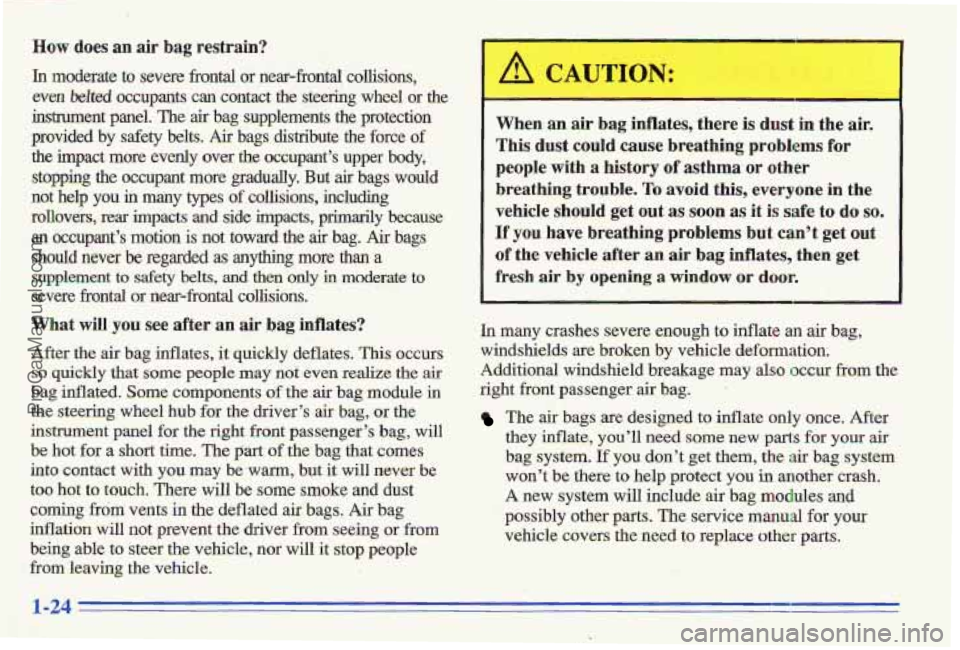
How does an air bag restrain?
In moderate to severe frontal or near-frond, collisions,
even belted occupants can contact the steering wheel or the
instrument panel. The
air bag supplements the protection
provided by safety belts.
Air bags distribute the force of
the impact more evenly over the occupant’s upper body,
stopping
the occupant more gradually. But air bags would
not help you
in many types of collisions, including
rollovers,
rear impacts and side hpacts, prirndy because
an occupant’s motion is not toward the air bag. Air bags
should never be regarded as anmg more than a
supplement
to safety belts, and then only in moderate to
severe fbntal or near-frontal collisions.
What will you see after an ais bag inflates?
After the air bag Mates, it quickly deflates, This occurs
so quickly that some people may not even realize the air
bag inflated. Some components of the.air bag module in
the steering wheel hub for the driver’s
air bag, or the
instrument panel for
the right front passenger’s bag, will
be hot for a short time. The part of the bag that comes
into contact with you may be warm, but it will never be
too hot to touch. There will be some smoke and dust
coming from’
vents in the deflated air bags. Air bag
inflation
will not prevent the driver from seeing or from
being able to steer the vehicle, nor will it stop people
from leaving the vehicle.
When an air bag inflates, there is dust in the air.
This dust could cause breathing problems for
people with
a history of asthma,or other
breathing trouble.
To avoid this, everyone in the
vehicle should get out as
soon as it is safe to do so.
If you have breathing problems but can’t get out
of the vehicle after an air bag inflates, then get
fresh air by opening a
window or door.
In many crashes severe enough to inflate an air bag,
windshields
are broken by vehicle deformation.
Additional windshield breakage may
also occur from the
right front passenger
air bag. .
The air bags ,are designed to inflate only once. After
they inflate, you’ll need
some new parts for your air
bag system. If y0u don’t get them, the air bag system
won’t
be there to help protect you in another crash,
A new system will include air bag modules and
possibly other parts. The service manual €or your
vehicle covers the need
to replace other parts.
1-24 L
ProCarManuals.com
Page 33 of 356
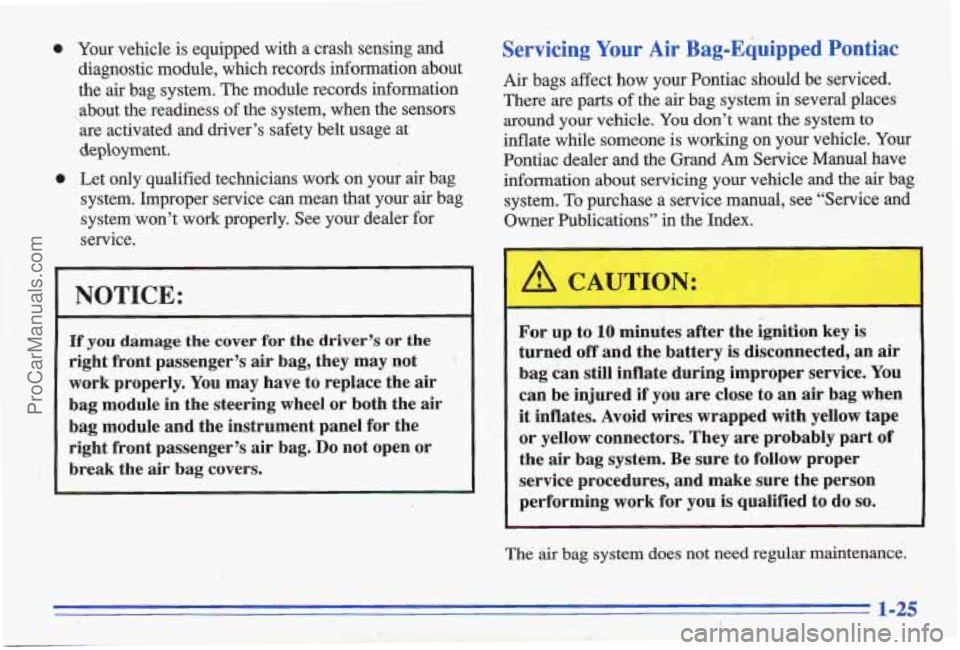
0
0
Your vehicle is equipped with a crash sensing and
diagnostic module, which records information about
the air bag system. The module records information
about the readiness of the system, when the sensors
are activated and driver’s safety belt usage at
deployment.
Let only qualified technicians work on your air bag
system. Improper service can mean that your air bag
system ‘won’t work properly. See your dealer for
service.
NOTICE:
If you damage the cover for the driver’s or the
right front passenger’s air bag, they may not
‘3
work properly. You may have to replace the air
bag module in the steering wheel or both the air
bag module and the instrument panel
for the
right front passenger’s air bag.
Do not open or
break the
air bag covers.
Servicing Your Air Bag-Equipped Pontiac
Air bags affect how your Pontiac should be serviced.
There are parts
of the air bag system in several places
around your vehicle.
You don’t want the system to
inflate while someone is working on your vehicle. Your
Pontiac dealer and the Grand Am Service Manual have
information about servicing your vehicle and the
air bag
system.
To purchase a service manual, see “Service and
Owner Publications’’ in the Index.
For
up to 10 minutes after the ignition key is
turned off and the battery is disconnected, an
air
bag can still inflate during improper service. You
can be injured if you are close to an air bag when
it inflates. Avoid wires wrapped with yellow tape
or yellow connectors. They
are probably part of
the air bag system. Be sure to follow proper
service procedures, and make sure the person
performing work for you is qualified to do
so.
The air bag system does not need regular maintenance.
2
=.~. , 1-25
ProCarManuals.com
Page 65 of 356

Trunk Security Override
The remote trunk release is
equipped with an override
feature to help prevent
unauthorized entry into the
trunk when leaving the
vehicle unattended. The
switch is located on the
inside
of the trunk lid,
mounted to the trunk lid
latch.
To turn the override feature on, slide the switch all the
way to the right.
To turn the override. feature off, slide
the switch all the way to the left.
When the override is on, the mechanical remote trunk
release will not release the trunk lid. However, the
trunk
lid can still be opened with the key.
This lockout feature is only available on vehicles that do
not have the Keyless Entry System.
Theft
Vehicle theft is big business, especially in some cities.
Although your Pontiac has
a number of theft-deterrent
features, we know that nothing we put on it can make it
impossible to steal. However, there
are ways you can
help.
Key in the Ignition
If you leave your vehicle with the keys inside, it’s an
easy target for joy riders or professional thieves -- so
don’t do it.
When you park your Pontiac and open the driver’s door, you’ll hear
a chime reminding you to remove your key
from the ignition and take it with you. Always do this.
Your steering wheel will be locked, and
so will your
ignition.
If you have an automatic transaxle, taking your
key out also locks your transaxle.
And remember to lock
the doors.
Parking at Night
Park in a lighted spot, close all windows and lock your
vehicle. Remember to keep your valuables out
of sight.
Put them in a storage area, or take them with you.
2-9
ProCarManuals.com
Page 67 of 356
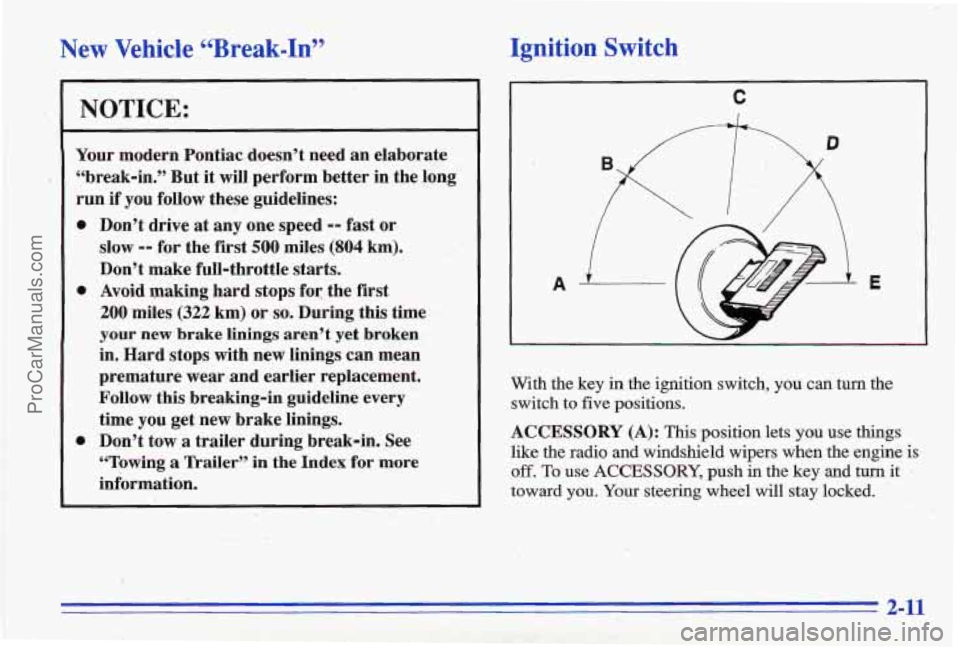
New Vehicle.“Break-In” Ignition
Switch
NOTICE:
Your modern Pontiac doesn’t need an elaborate
“break-in.” But it will perform better in the long
run if you follow these guidelines:
0
0
0 Don’t drive at any one speed -- fast or
slow
-- for the first 500 miles (804 km).
Don’t make.ful1-throttle starts.
Avoid making hard stops
for the first
200 miles (322 km) or so. During this time
your new brake linings aren’t yet broken
in. Hard stops with new linings can mean
premature wear .and earlier replacement.
Follow
this breaking-in guideline every
time you get new brake linings.
Don’t tow
a trailer during break-in. See
“Towing
a Trailer” in the Index for more
information.
C
A E
W
With the key in the ignition switch, you can turn the
switch
to five positions.
ACCESSORY (A): This position lets you use things
like the radio and windshield wipers when the engine is
off. To use ACCESSORY, push in the key and turn it
toward
you. Your steering wheel will stay locked.
..
ProCarManuals.com
Page 68 of 356

LOCK (B): Before you pur: the key into the ignition
switch, the switch is
in LOCK. It’s also the only position
in which you can remove the key. This locks your
steering wheel, ignition and transaxle
(on automatic
models).
OFF (C): This position unlocks the steering wheel,
ignition,
and transaxle (on automatic models), but does
not send electrical power to any accessories. Use this
position
if your vehicle must be pushed or towed, but
never
try to push-start your vehicle. A warning chime
will sound if you open the driver’s
door when the
ignition
is off and the key is in the ignition. 1
RUN (D): This position is where the key returns after
you
start your engine and release the switch. The switch
stays
in the RUN position when the engine is running.
But even when the engine
is not running, you can use
RUN to operate your electrical power accessories, and
to display
some instrument panel warning lights.
START (E): This position starts your engine. When the
engine
starts, release the key. The ignition switch will
return
to RUN for normal driving.
Note that even if the engine is not running, the positions
ACCESSORY and RUN are on positions that allow you
to operate your electrical accessories, such as the radio. On manual transaxle
vehicles, turning the key to
LOCK will lock the steering column and result in
a loss of ability to steer the vehicle. This could
cause
a collision. If you need to turn the engine
off while the vehicle is moving, turn the key only
to
OFF. Don’t press the key release button while
the vehicle is moving.
NOTICE:
If your key seems stuck in LOCK and you can’t
turn it,
be sure it is all the way in. If it is, then
turn the steering wheel
left and right while you
turn the key hard. But turn the key only with
your hand. Using a tool to force it could break
the key or the ignition switch. If none of this
works, then your vehicle needs service.
2-12
ProCarManuals.com
Page 86 of 356
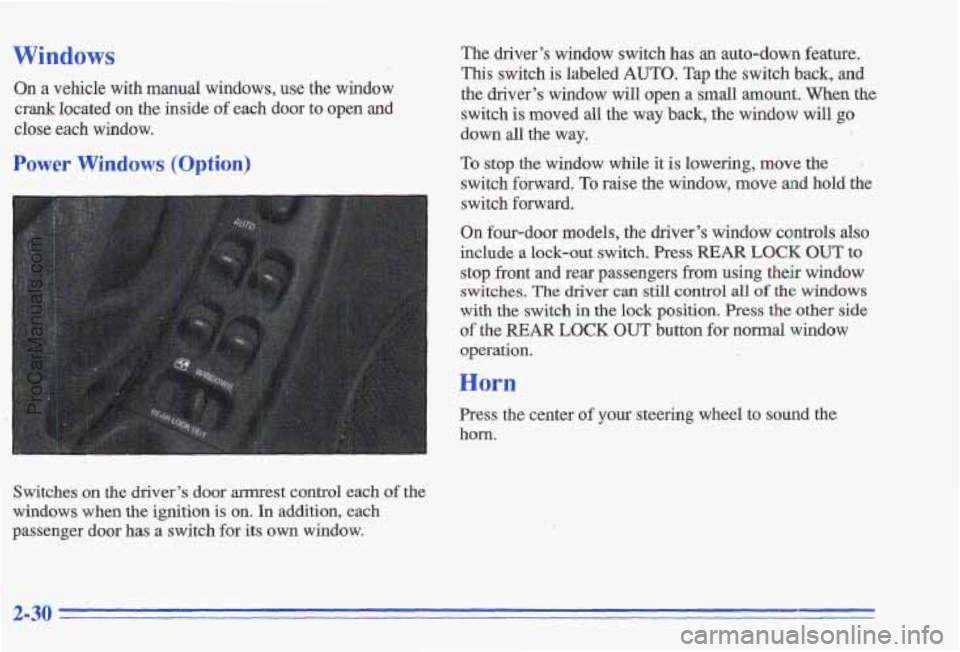
Windows
On a vehicle with manual windows, use the window
crank located on the inside of each door to open and
close each window.
Power Windows (Option)
Switches on the driver’s door armrest control each of the
windows when the ignition is on.
In addition, each
passenger door has a switch for its own window. The driver’s window switch has
an auto-down feature.
This switch
is labeled AUTO. Tap the switch back, and
the driver’s window will open a
small amount. When the
switch is moved all the way back, the window will go
down all the way.
To stop the window while it is lowering, move the .
switch forward. To raise the window, move and hold the
switch forward.
On four-door models, the driver’s window controls also
include a lock-out switch.
Press REAR LOCK OUT to
stop front and rear passengers from using their window switches.
The driver can still control all of the windows
with the switch in the lock position. Press the other side
of the
REAR LOCK OUT button for normal window
operation.
--
Horn
Press the center of your steering wheel to sound the
horn.
2-30
ProCarManuals.com